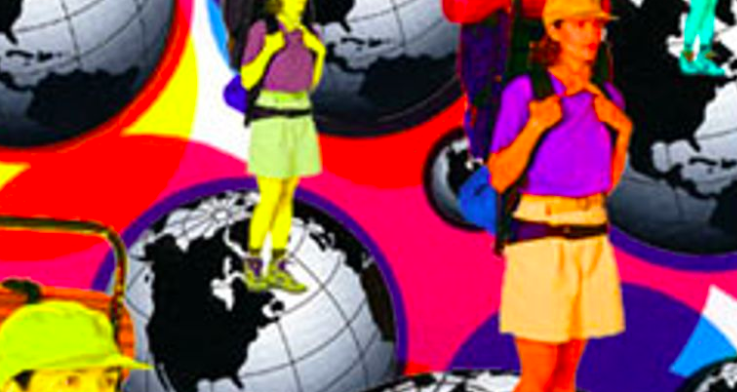As he leaves Southeast Asia, our Vagabonding correspondent reflects on the evolution of the middle-class travel revolution.
By Rolf Potts
Three hours before I’m due to fly out of Bangkok, I take one last stroll down the swirl of sights and sounds that is Khao San Road. This is my final visit to Thailand’s famous backpacker ghetto, and — since I’ve spent more than 20 nights here since arriving in Southeast Asia last December — I have returned to savor this place one last time.
Out in the street, young travelers from countries such as Switzerland, Israel and New Zealand nurse beers at plastic tables, while others line up at food stalls to sample sliced pineapple, vegetarian noodles and banana pancakes. Tuk-tuk drivers hail passengers at the corner, while Indian tailors pace the sidewalk in front of their stores, chanting their standard mantra (“Sir, try a suit. Very good price, sir.”). Sidewalk vendors hawk jewelry and cigarette lighters, bootleg tapes and fake press passes; storefront vendors sell souvenirs ranging from Nepalese jackets to Balinese masks to novelty T-shirts that read “SEX INSTRUCTOR (First Lesson Free).”
In the alleys, uncertain dogs jog through the shadows, unowned and omnipresent. Placards advertise tattoo parlors and laundry services, traditional massages and hemp-fiber clothing. Colorful stickers on travel agency windows advertise bus and ferry services to Phuket, Ko Samui, Ko Phi Phi and Chiang Mai. Backpackers crowd into dingy Internet cafes to check their Hotmail accounts and surf the Web for travel updates, while suspiciously healthy-looking kids prowl the street with small cards that read “I want to go to school. Please give me 10 baht.” Video movie noises rumble out from open-front restaurants, blasting that time-honored Hollywood litany of screams and explosions, of people calling each other bastards and sons of bitches.
Sometime next spring, a Leonardo DiCaprio movie called “The Beach” will forever change the way people see this corner of Bangkok. As the hype surrounding the release of the movie kicks into high gear, reporters from around the world will descend on Khao San Road to make their own wide-eyed assessments of this scene. This publicity, along with the movie itself, will inject a new romantic stereotype into a place that is already over-romanticized and over-stereotyped.
Everyone who lives or travels in Thailand, it seems, has their own assessment of what Khao San Road represents. Local Thais, whose opinions are fueled by a sensationalistic press, consider Khao San Road a place of drugs and licentiousness, of freaks and cheapskates. Bangkok expats dismiss Khao San Road as host to a steady rotation of unwashed cretins who call each other “dude” and sit around comparing tattoos. Upscale tourists avoid the place as instinctively as they would seedy neighborhoods in their own hometowns.
But perhaps the harshest critics of Khao San Road are the backpack travelers themselves, who consider the place a watered-down version of Asia — a tie-dyed front for conveyor-belt tourism, an insipid gathering place for pseudo-hippies and hipster wannabes. “The Khao San Road scene is way too clichi for my taste,” I once overheard a young traveler confide to her friend. They were both sitting in a cafe on Khao San Road at the time.
In reality, Khao San Road is a place that slithers inside its own stereotype. As Alex Garland wrote in “The Beach,” the novel on which the movie is based, Khao San Road is “a decompression chamber for those about to leave or enter Thailand; a halfway house between the East and the West.” Khao San Road is not designed to be a static, aesthetic part of Thailand, but a pragmatic duty-free zone — a neutral territory that has learned to continually reinvent itself in the image of what young budget travelers want.
In this way, Khao San Road stands as an apt symbol of a travel revolution that began a decade ago and has almost been completed.
Most people are probably not aware that this travel revolution is in progress — let alone that it’s almost over. This is because the revolution has been carried out by a mocked and maligned entity known as the middle-class world citizen. Middle-class people, after all, don’t have revolutions; middle-class people have trends.
In his 1988 book “Video Night in Kathmandu,” Pico Iyer called tourists “foot soldiers of the new invasion.” At the time, he was referring to the expansion of Western culture into once-isolated parts of Asia, but his observation also underscored a simple fact: that Westerners of moderate means were increasingly able to access and enjoy less expensive parts of the world. “Anyone with a credit card,” Iyer observed, “could become a lay colonialist.”
Not long after Iyer wrote this, the fears and assumptions of the Cold War were abruptly rubbed out and replaced with a phenomenon dubiously dubbed the End of History. Suddenly, after 70-odd years of world wars and cold wars and great depressions, the world’s frontiers began to open up in an unprecedented manner. New travel destinations sprang up in places like Romania and Namibia and Cambodia. Iyer’s tourist “foot soldiers” quietly began a revolution based upon a single screaming secret: that anyone with a bit of initiative and a decent guidebook could afford to leave home and seek out their own variation of paradise.
The problem, of course, was that it didn’t take long for these brand-new paradises to become very crowded places. Moviegoers who watch “The Beach” will see this notion illustrated in a very vivid manner.
But beyond aesthetics, the middle-class travel revolution wreaked havoc on our accepted ideas of exclusivity. Traditionally, international leisure travel had been a luxury of the rich, and independent shoestring travel had been a counterculture franchise. However — as more and more 18- to 35-year-olds made their way into the sleepy, inexpensive corners of the world — the once-cozy alternative leisure-class became socially crowded. Since countercultures tend to replace conventional hierarchies with more arbitrary ones, this resulted in an ill-defined (and sometimes hostile) protective morality that pervades backpacker circles to this day. This also is vividly illustrated in “The Beach.”
Currently, much of this puritanical chagrin is focused on a budget-travel publishing company called Lonely Planet. First written on a kitchen table in Melbourne more than 25 years ago, Lonely Planet started out as a photocopied travel newsletter and has since grown into the largest independent travel publisher in the world. Sometimes referred to as the “Backpacker’s Bible,” the Lonely Planet guidebook stresses cultural and environmental awareness, and has been instrumental in opening up many parts of the world to penny-pinching wanderers.
The problem many travelers have with Lonely Planet, however, is that the Backpacker’s Bible has won too many fundamentalist converts. Popularity has resulted in hegemony, hegemony has resulted in backpacker ghettos and backpacker ghettos make travelers feel like they never left home. As one of the characters says in Garland’s novel, “One of these days I’m going to find one of those Lonely Planet writers and I’m going to ask him, ‘What’s so fucking lonely about Khao San Road?’”
At the heart of this travel puritanism lies a slippery question: What, in this day and age, is the correct way to travel?
A century or so ago, this question wasn’t an issue, since the only people who traveled were soldiers, sailors, merchants and explorers. Later, when Victorian-Age prosperity spawned the gentleman and gentlewoman adventurer (the prototype, however remote, of today’s world traveler), this question was still not that important, since international travel was merely a method of showcasing one’s status to the folks back home.
These days, however — with world travel turning into one big, grudging egalitarian democracy — we are compelled to aspire to a greater ethic in our wandering. Since as members of a mass culture, we resent being mere consumers, we have been forced to look for something that goes beyond social status and financial mobility. Defining how we travel, in effect, has become a matter of individualist self-perception: It has become inseparable from how we define ourselves.
Some travelers in Southeast Asia (the party crowd that haunts the islands of southern Thailand comes to mind) define themselves in terms of fashionable anonymity and self-gratification. Others, perhaps taking the budget-travel role too seriously, pride themselves on traveling with as little money and information as possible, defining themselves through a minimalist-obscurist sense of one-downsmanship.
The most dynamic demographic within the new travel morality, however, encompasses the folks who try to abide by the laws of “cultural sensitivity” — which stress education over recreation, and interactions over transactions. Since this is the most visible and self-aware sub-group within the backpacker milieu, it will certainly bear the most scrutiny when the independent travel phenomenon enjoys its brief window of movie-related publicity this spring.
Fortunately for the pundits, there are countless hairs to split when examining the philosophies behind culturally sensitive travel. This is because the central conceit of “cultural sensitivity” is that it plays games with our displacement as travelers — it shuns the role of tourist by mimicking the role of insider. And — considering how it’s almost impossible to separate objective standards of sensitivity from our sentimentalized notions of how the world should be — this opens up the proverbial can of worms.
Is the traveler who hikes into the jungle to interact with the natives having an authentic intercultural experience, or is he negatively interfering with the natives’ lives by flaunting his modern, internationally mobile lifestyle? Is the traveler’s unconditional respect for people’s archaic lifestyles doing them any good if their life expectancy is 47 years, their infant morality rate is 15 percent and their literacy is nil?
Furthermore, isn’t temporary friendship a self-indulgent gesture when the people the traveler befriends will likely never see him again, and might have benefited more from a less personal but more tangible contribution to their economy? Aren’t — by literal standards of cultural sensitivity — the best travelers actually the herd-like group tourists, who experience the country from the safety of their air-conditioned buses and don’t disrupt anything that hasn’t already been disrupted?
Though such questions make for interesting debates, the attempt to impose a static model of travel correctness is ultimately self-defeating, since — rhetorically, at least — the most culturally sensitive travel option is to stay home.
– – – – – – – – – – – –
Just before I leave for the A2 airport bus stop, Khao San Road gives me one last surprise. A couple hundred yards down the street from me, crowds of travelers part to make room as a fife-and-drum corps composed of tourist-police officers marches its way up the road. Clad in crisp brown uniforms, knee-high leather boots and shiny motorcycle helmets, the officers belt out a tuneless dirge, looking as anomalous here as space aliens. All along the sidewalk, travelers stop to smile at this unexpected sight, and for an odd moment, this corner of Bangkok seems downright magical.
In its own way, Khao San Road is a triumph: It is a quirky microcosm of how the world is changing — and how the world is changing the way we see ourselves.
In a few more months, the middle-class travel revolution will end as all middle-class movements do: with assimilation. Once “The Beach” hits the theaters, the notion of independent world travel will be officially mainstreamed into the Western psyche — and the world as we know it will be conquered for the umpteenth time.
Fortunately, the ramifications of world conquest aren’t as spiritually empty as they might seem. In a personal sense, the world has only grown larger and wider and wilder. Travel is and always will be an act of faith and creativity — even more so as it comes to resemble the lives we lead at home. And, while the social implications of globetrotting may have become hopelessly complicated, this merely allows us to reclaim travel for what it should be: a private act of discovery.
As the crash-helmeted fife-and-drum corps reaches the end of the street and makes a hard right turn, Khao San Road resumes its dynamic hum. I shoulder my pack and walk into a world that is more laced with possibility than ever.





